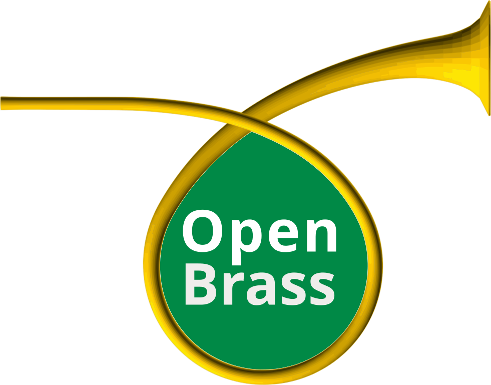Several sources outline quickly the function of the bell, the leadpipe and the mouthpiece.
This study is made to give more details regarding the effect of a progressive transformation of a cylinder into a trumpet.
The distinction between the leadpipe, the mouthpiece cup and mouthpiece shank will permit us to understand each of their role.
The leadpipe is a simple cone.
The two-part mouthpiece is simplified by a conical tail and a spherical shaped cup (circle in 2D).
This makes it possible to simplify a 3D modeling while maintaining a good reliability whatever the form is.
The walls are considered rigid.
Coupling with an instrumentalist is not simulated.
For this purpose, 4 parameters will fluctuate:
- bell's percentage
- leadpipe's percentage
- mouthpiece shank's percentage
- mouthpiece cup's percentage
- Simple cylinder
- Bell 25%, 50%, 75%, 100%
- Bell + Leadpipe 50%, 100%
- Bell + Leadpipe + Mouthpiece shank 25%, 50%, 75%, 100%
- Bell + Leadpipe + Mouthpiece shank + Mouthpiece cup 25%, 50%, 75%, 100%
Detailed representation of the leadpipe to the mouthpiece:
Simulation's magnitude:
Simulation's phase :
 VS:
VS:  VS:
VS: The formation of the bell raises the overall low (~ 400 cents more) but also decreases the higher resonances (~ 80 cents less).
The influence of the size of the bell seems less and less important as the bell grows.
The notes seem, with the bell alone, already close to those played finally by a trumpet.
Magnitude / Phase :
On the impedance curve, it decreases the height of the higher resonances. It acts as a low-pass filter.
The leadpipe
It deforms the first two resonances very much. (~ 220 cents)
Magnitude / Phase :
The peaks of impedances up to that time quite straight, begin to lean slightly towards the higher resonances.
The shank of mouthpiece
The effect is overall to raise the lower resonances. (~ 55 cents for the 3rd resonance)
With the leadpipe, the effect is similar to the bell's effect.
Between 75% and 100% the difference of ~ 1 mm (over the diameter) causes a shift of ~ 10 cents in the lower resonances against ~ 3 for higher's.
In comparison, ~ 1 mm deviation on the bell does change a maximum of ~ 1.4 cents in the pitch.
Magnitude / Phase :
This seems to accentuate the low-pass filter effect of the bell by further reducing the magnitude of the higher peaks.
The peaks are even more bending towards the higher's resonances (less and less straight).
The cup of mouthpiece
The cup of the mouthpiece seems to bring down all the harmonics but not in the same way.
A peak appears around the 13th resonance that seems to pull the others down.(-50 cents).
Unlike the bell, which has less and less influence, it grows more and more influential.
A small change of form can therefore have a great influence on tuning.
The simplification of its form does not allow us to go into details about its effect, but it seem coherent with other studies on mouthpieces (ARCHIVE - https://iwk.mdw.ac.at/?page_id=86&sprache=2).
Magnitude / Phase :
The peaks that have been bending towards the treble are gradually straightened. The treble now bends towards the lower resonances, and the lower towards the higher's around the 6th resonance which is almost straight. The peaks strongly lowered by the leadpipe and the shank of mouthpiece go up a little except for the highers which remains weak.
The study presents the gradual transformation of a cylinder into a trumpet, which makes it possible to understand how we can fall back on notes close to the series of natural harmonics.
In theory, a cone resonates on the sequence of natural harmonics.
In an instrument like the trumpet, the "cone" of the bell allows to approach it but is not yet sufficient.
The leadpipe and the shank of the moutpiece close a lillte this cone and thus improve the resonance sequence.
An equilibrium is reached only for the first resonances (until the 13th in our case) by the effect of the cup of the mouthpiece.
A small change in the bell will just have a little effect on the pitch.
On the other hand, a small change in the mouthpiece can strongly affect it.
The study also shows the magnitude / phase curve that allows information such as the low-pass effect of the bell to be seen, as well as the impact of the shape of the mouthpiece on the amplitude of some notes.
- Brass instrument (lip reed) acoustics: an introduction - University of New South Wales (Joe Wolfe) - http://newt.phys.unsw.edu.au/jw/brassacoustics.html
- Georgia State University - HyperPhysics - http://hyperphysics.phy-astr.gsu.edu/hbase/Music/brassa.html
- ARCHIVE - Examination of the Influence of Different Mouthpiece Forms on the Resonance Behavior of Trumpets - WIENER KLANGSTIL (IWK) - https://web.archive.org/web/20160701184242/https://iwk.mdw.ac.at/?page_id=86&sprache=2
Last modification 2022-05-20
Texts and medias are available under the Creative Commons Attribution-ShareAlike License
